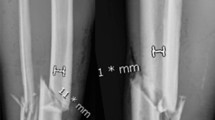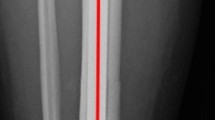Abstract
Purpose
This retrospective study aimed to assess the impact of distal nail placement on misalignment and healing rates in distal tibial fractures.
Methods
We reviewed all patients with distal tibial fracture treated with intramedullary nailing between 2015 and 2021, and a minimum follow-up of 12 months. Distal nail positioning was determined according to the Triantafillou zones. We related these positioning zones to misalignments (alignment ≥ 3°) and too bony union disorders (delayed union, non-union).
Results
Out of the 62 patients included, 56 (90.3%) show bone union without additional procedure, 3 (4.8%) with dynamization, and 3 (4.8%) showed non-union. Twenty-one (33.8%) presented misalignment, with valgus in the coronal plane being the most frequent (76.19%). In patients with and without misalignment, the most frequent distal nail position was 2–2 in 47.6% and 80.5%, respectively (p = 0.01). In multivariate analysis, distal nail positioning in the 2–2 zone showed a significant protective effect against misalignment (OR 0.18; p = 0.018), while nail positioning in the 3–2 zone generated a significant risk of misalignment (OR 18.55; p = 0.009).
Conclusion
In intramedullary nailing of distal tibial fractures, distal positioning of the nail slightly lateral to the center of the talus in the coronal plane and slightly posterior in the sagittal plane (zone 2–2) allows high alignment percentages to be obtained. Positioning medial to this point in the coronal plane (zone 3) is associated with more significant misalignment and should be avoided.



Similar content being viewed by others
Availability of data and material
All data generated and analyzed during this study are included in this published article and are available from the corresponding author on reasonable request.
References
Aneja A, Marquez A, Luo TD, Teasdall RJ, Albano A, Halvorson JJ, Carroll EA (2022) Rethinking the coronal anatomic axis of the distal tibia for intramedullary nail placement: a cadaveric study. HSS J 18(2):284–289. https://doi.org/10.1177/15563316211008176
Wang B, Zhao Y, Wang Q, Hu B, Sun L, Ren C, Li Z, Zhang K, Hao D, Ma T, Lu Y (2019) Minimally invasive percutaneous plate osteosynthesis versus intramedullary nail fixation for distal tibial fractures: a systematic review and meta-analysis. J Orthop Surg Res 14(1):456. https://doi.org/10.1186/s13018-019-1479-0
Brinkmann E, DiSilvio F, Tripp M, Bernstein M, Summers H, Lack WD (2019) Distal nail target and alignment of distal tibia fractures. J Orthop Trauma 33(3):137–142. https://doi.org/10.1097/BOT.0000000000001358
Yoon R, Liporace F (2016) Intramedullary nail and plate combination fixation for complex distal tibia fractures: When and how? J Orthop Trauma 30(4):S17–S21. https://doi.org/10.1097/BOT.0000000000000698
Avilucea F, Triantafillou K, Whiting P, Perez E, Mir H (2016) Suprapatellar intramedullary nail technique lowers rate of malalignment of distal tibia fractures. J Orthop Trauma 30(10):557–560. https://doi.org/10.1097/BOT.0000000000000631
Maslow JI, Joseph HL, Hong DY, Henry AL, Mitchell PM, Collinge CA (2020) Radiographic evaluation of the tibial intramedullary nail entry point. J Am Acad Orthop Surg 28(18):e810–e814. https://doi.org/10.5435/JAAOS-D-19-00557
Egol KA, Weisz R, Hiebert R, Tejwani NC, Koval KJ, Sanders RW (2006) Does fibular plating improves alignment after intramedullary nailing of distal metaphyseal tibial fractures? J Orthop Trauma 20(2):94–103. https://doi.org/10.1097/01.bot.0000199118.61229.70
Krettek C, Stephan C, Schandelmaier P, Richter M, Pape HC, Miclau T (1999) The use of Poller screws as blocking screws in stabilizing tibial fractures treated with small diameter intramedullary nails. J Bone Joint Surg Br 81(6):963–968. https://doi.org/10.1302/0301-620x.81b6.10000
Lu Y, Yang J, Xu Y, Ma T, Li M, Ren C, Huang Q, Zhang C, Wang Q, Li Z, Zhang K (2021) An approach to intraoperatively identify the coronal plane deformities of the distal tibia when treating tibial fractures with intramedullary nail fixation: a retrospective study. Orthop Surg 14(2):365–373. https://doi.org/10.1111/os.13194
Zelle BA, Boni G (2015) Safe surgical technique: intramedullary nail fixation of tibial shaft fractures. Patient Saf Surg 9:40. https://doi.org/10.1186/s13037-015-0086-1
De Giacomo AF, Tornetta P (2016) Alignment after intramedullary nailing of distal tibia fractures without fibula fixation. J Orthop Trauma 30:561–567. https://doi.org/10.1097/BOT.0000000000000637
Triantafillou K, Barcak E, Villarreal A, Collinge C, Perez E (2017) Proper distal placement of tibial nail improves rate of malalignment for distal tibia fractures. J Orthop Trauma 31(12):e407–e411. https://doi.org/10.1097/BOT.0000000000000989
Beebe MJ, Morwood M, Serrano R, Quade JH, Auston DA, Watson DT, Sanders RW, Mir HR (2019) Extreme nailing: is it safe to allow immediate weightbearing after intramedullary nail fixation of extra-articular distal tibial fractures (OTA/AO 43-A)? J Orthop Trauma 33(8):392–396. https://doi.org/10.1097/BOT.0000000000001484
Vallier H, Cureton B, Patterson B (2011) Randomized, prospective comparison of plate versus intramedullary nail fixation for distal tibia shaft fractures. J Orthop Trauma 25(12):736–741. https://doi.org/10.1097/BOT.0b013e318213f709
Garabano G, Pereira S, Perez Alamino L, Ernst G, Pesciallo CA, Bidolegui F (2022) The relevance of the number of distal locking planes and nail to canal ratio in bone healing after intramedullary nailing in tibial shaft fractures. Eur J Orthop Surg Traumatol. https://doi.org/10.1007/s00590-022-03401-0
Olerud C, Molander H (1978) A scoring scale for symptom evaluation after ankle fracture. Arch Orth Traum Surg 103(3):190–194. https://doi.org/10.1007/BF00435553
Ware J Jr, Kosinski M, Keller SD (1996) A 12-item short-form health survey: construction of scales and preliminary tests of reliability and validity. Med Care 34(3):220–233. https://doi.org/10.1097/00005650-199603000-00003
Gorczyca JT (2001) Tibial shaft fractures. In: Brinker MR (ed) Review of Orthopedics Trauma. Saunders, Philadelphia, pp 2127–2142
Pesciallo CA, Garabano G, Alamino LP, Dainotto TL, Gaggiotti S, Del Sel H (2021) Effectiveness of nail dynamization in delayed union of tibial shaft fractures: relationship between fracture morphology, callus diameter, and union rates. Indian J Orthop 56(3):386–391. https://doi.org/10.1007/s43465-021-00523-1
Brodke DJ, Upfill-Brown A, Devana SK (2022) A critical analysis of lateral versus central endpoint in distal tibia nailing: does it affect alignment? J Orthop Trauma 36(8):400–405. https://doi.org/10.1097/BOT.0000000000002345
Trompeter A, Williamson M, Bates P, Petersik A, Kelly M (2021) Defining the Ideal “Nail Exit Path” of a tibial intramedullary nail-a computed tomography analysis of 860 tibiae. J Orthop Trauma 35(11):e392–e396. https://doi.org/10.1097/BOT.0000000000002098
Kruppa C, Hoffmann M, Sietsema D, Mulder M, Jones C (2015) Outcomes after intramedullary nailing of distal tibial fractures. J Orthop Trauma 29(9):e309–e315. https://doi.org/10.1097/BOT.0000000000000323
MoongilpattiSendogan M, Vaidyanathan S, Karunanandaganapathy S, Subbiah Subramanian S, Rajamani SG (2014) Distal tibial metaphyseal fractures: does blocking screw extend the indication of intramedullary nailing? ISRN Orthop. https://doi.org/10.1155/2014/542623
Funding
No funds, grants, or other support was received.
Author information
Authors and Affiliations
Contributions
All authors contributed to the study´s conception and design. Material preparation, data collection, and analysis were performed by German Garabano, Adrian Jaime, and Leonel Perez Alamino. The first draft of the manuscript was written by German Garabano and Adrian Jaime. All authors read and approved the final manuscript.
Corresponding author
Ethics declarations
Conflict of interest
The authors have no relevant financial or non-financial interests to disclose. The authors have no competing interest to declare that are relevant to the content of this article. All authors certify that they have no affiliations with or involvement in any organization or entity with any financial interest or non-financial interest in the subject matter or materials discussed in this manuscript. The authors have no financial or proprietary interests in any material discussed in this article.
Ethical approval
All procedures performed in studies involving human participants were in accordance with the ethical standards of the British Hospital and/or national research committee and with the 1964 Helsinki Declaration and its later amendments or comparable ethical standards. (Project Number 9429).
Informed consent
Informed consent was obtained from all individual participants included in the study.
Additional information
Publisher's Note
Springer Nature remains neutral with regard to jurisdictional claims in published maps and institutional affiliations.
Rights and permissions
Springer Nature or its licensor (e.g. a society or other partner) holds exclusive rights to this article under a publishing agreement with the author(s) or other rightsholder(s); author self-archiving of the accepted manuscript version of this article is solely governed by the terms of such publishing agreement and applicable law.
About this article
Cite this article
Garabano, G., Jaime, A., Alamino, L.P. et al. Does the distal nail position impact the rates of misalignment and bone union in distal tibial fractures?. Eur J Orthop Surg Traumatol 33, 3365–3371 (2023). https://doi.org/10.1007/s00590-023-03566-2
Received:
Accepted:
Published:
Issue Date:
DOI: https://doi.org/10.1007/s00590-023-03566-2




